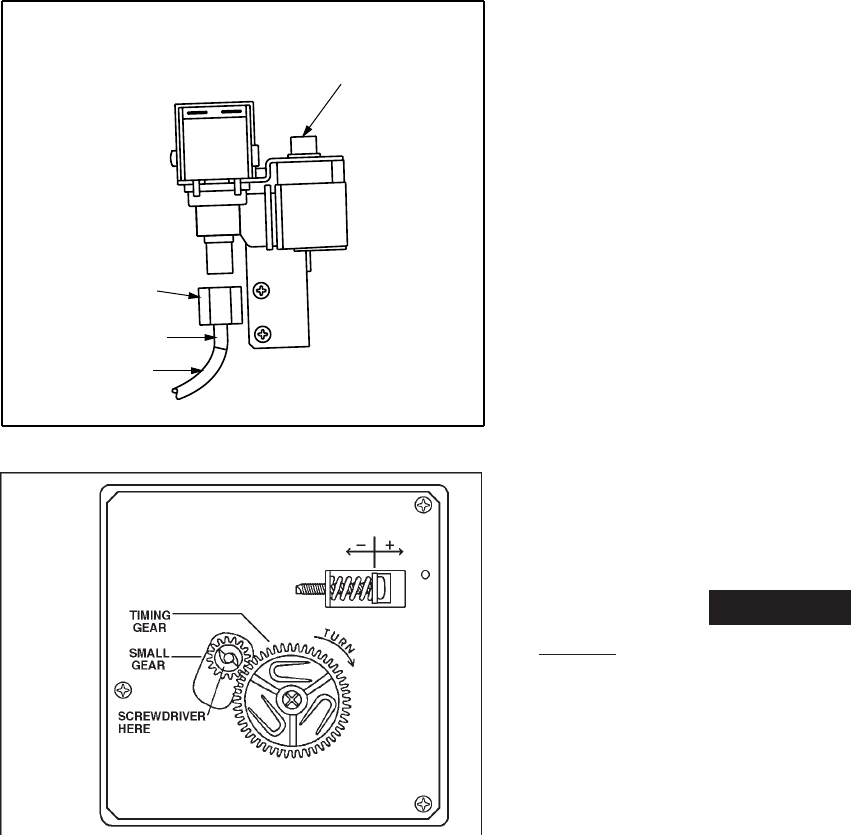
16
6. Connect compressed air onto the inlet fitting of the
water solenoid valve. See FIG. 14. Apply AC power
to the solenoid valve by forcing the ice maker mold
assembly through several harvest cycles. Remove
the plastic cover from the mold assembly. The bail
arm must be in the down (“ON”) position. Start the
harvest cycle with a flat blade screw driver inserted
into the center of the small gear. Turn the gear
counterclockwise, when the hold switch closes, the
mold assembly will continue to operate through the
harvest cycle. See FIG. 15. During the water fill
sequence of the harvest cycle the compressed air
will blow out the water trapped in the solenoid
valve. Repeat the harvest cycle operation several
times.
Note: Up to 20 PSIG air pressure can be used to clear
the solenoid valve. Damage to solenoid can occur if AC
power is applied for more than 20 seconds.
7. Make sure that the metal tube is in the plastic water
line to the ice maker. Reconnect and tighten lines
on water solenoid valve. Leave the water supply
turned off until temperatures are above 0°F/-18°C.
See figure 14.
8. Dry out the ice maker mold assembly with a soft
cloth. Place bail arm in the “UP/OFF” position.
MAINTENANCE & SERVICE
The user should be aware of service that must be
done on a regular schedule to keep the refrigerator
operating properly. The service should only be per-
formed by a qualified technician who is familiar with
LP gas systems and refrigerators.
1. REFRIGERATOR REMOVAL
Before working on the refrigerator, make sure the AC
voltage and DC voltage leads are disconnected. Shut
off the gas supply. Disconnect the gas supply line at
the rear of the refrigerator see FIG. 1. Always use a
back up wrench when loosening and tightening this
connection. Cap the gas supply line loosen the screws
anchoring the refrigerator to the enclosure and slide
the refrigerator out of the compartment.
When replacing the refrigerator make sure that the
sealing strips are properly positioned.
Replacement is the reverse of removal. Check all con-
nections for gas leaks.
Refer to section INSTALLATION, page 5 to 9.
2. PERIODIC MAINTENANCE
To keep your Dometic refrigerator operating efficiently
and safely, periodic inspection and cleaning of sev-
eral components once or twice a year is recom-
mended.
A. It is important to keep the area at the back of the
refrigerator clean. Check the lower vent, upper vent
and area between these openings for any obstruc-
tions such as bird/insect nests, spider webs, etc.
Clean the coils on the back of the refrigerator. Use
a soft bristled brush to dust off the coils. The entire
cooling unit at the back must be kept clear from all
kinds of object that obstruct the air flow.
It is important to keep the refrigerator area free from
combustible material, gasoline and other flammable
vapors or liquids.
NOTE: The following maintenance is required once or
twice a year, but should only be done by a qualified ser-
viceman who is familiar with LP gas systems and refrig-
erators.
B. Check all connections in the LP gas system (at the
back of the refrigerator) for gas leaks. The LP gas
supply must be turned on. Apply a noncorrosive
bubble solution to all LP gas connections. The ap-
pearance of bubbles indicates a leak and should be
repaired immediately by a QUALIFIED SERVICEMAN
WHO IS FAMILIAR WITH GAS SYSTEM AND RE-
FRIGERATORS.
DO NOT use a flame to check for gas leaks.
C. The LP gas pressure should be checked and the main
regulator readjusted if pressure is incorrect.
The correct operating pressure is 11 inches of water
column. The correct place to take the LP gas pres-
sure is at the test port just ahead of the burner jet.
(See FIG. 16).
! WARNING
FIG. 15
FIG. 14
Inlet fitting for
water supply line
Plastic nut
Metal tube
1/4” Water line
to ice maker
Water solenoid valve


















